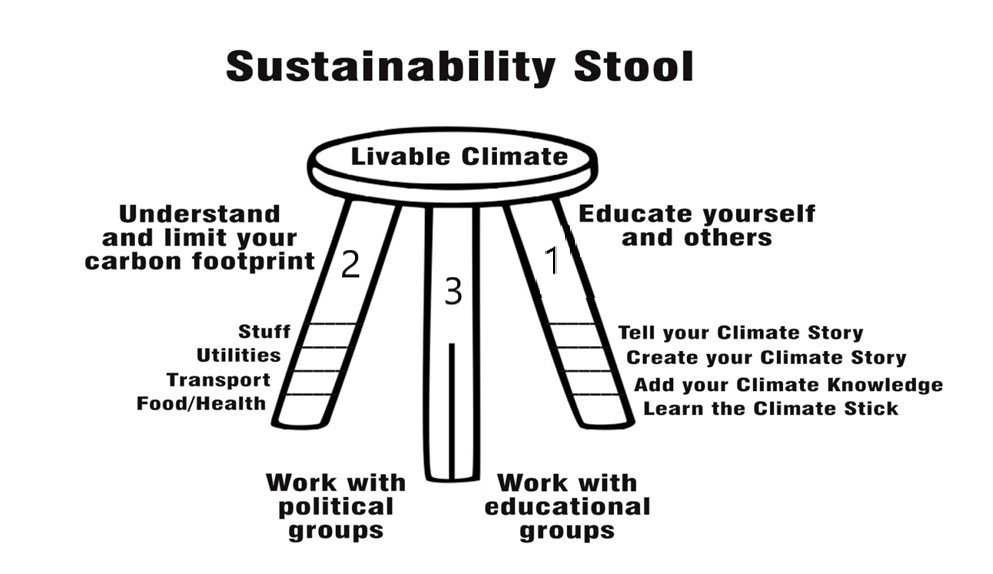
Polling has found that 60 to 70% of the US population has concerns about climate change. Yet there is a culture of silence that makes discussion very difficult. Polling also reveals that many of the same people who are concerned about climate change think negatively about those who discuss it in the media. The way to break this culture of silence is to “TALK CLIMATE”.
The feelings of “I’m alone”, “I do not know enough” and “how can I do anything about this huge problem?”, all prevent a mass movement of people who do oppose burning carbon and who want to make rational choices to preserve a livable climate. The Sustainability Stool helps you to create your own Climate Story with the Climate Stick so you can comfortably “TALK CLIMATE”.
Leg 1 Educate Yourself (and create your Climate Story): Most people already have a great deal of information about Climate Change and more information and images come in their view every day. The problem for a person who wants to understand and do something about Climate Change is that they need a way to organize some of this information so they can get a Climate Story that they are comfortable using in conversations with other people. That is what the Climate Stick is for. It is a starting point with the basic facts about CO2 right in front of you.
The process to get your Climate Story is to see what parts of the climate issue you are most comfortable with and then use that with the Climate Stick to develop your own Climate Story. There will be stock parts from the Climate Stick and unique parts that come from your concerns and the desired actions you want to take.
Leg 2 Personal Carbon Footprint Choices: Make choices that reflect your understanding that we must reduce our energy use and non-essential purchases now.
Food/Health Moving from eating a lot of red meat, to small amounts, or turning to chicken and fish only, or to a plant based diet without dairy products is a progression that reduces your carbon footprint (the move from red meat to chicken is an eightfold reduction in your carbon footprint) and makes a positive effect on your health.
Utilities/Transportation People, for example, commonly consider reduction in energy cost in a variety of ways in their normal decisions about transportation, home heating and electrical use. New technologies focused on homes can bring about greater savings, and integrating walking and bike riding can provide double benefits from reduced cost and improved personal health.
Stuff Use a carbon footprint analysis (do I really need this?) when thinking about buying that next thing. Children are given so many presents in the first 3 years of their lives that are really just a way for grandparents to feel happy. That stuff (and all the other feel good stuff purchased) is like a big deadly bullet they are sending to these little ones when they are in their twenties or thirties. Your stuff takes energy to make and “is it worth it to my children and grandchildren?” should be question that is asked about every purchase.
Leg 3 Working in Groups for Survival: Once you have a personal Climate Story then you can use it to inform others of your feelings about the unpleasant results of our not doing enough, quickly enough, to end the burning of carbon. When there are two of you, you have a group to share the work of informing and motivation others. As your little group grows you will find organized groups, or you may already belong to an organized group or two. Bring your knowledge and your story about Climate Change to these groups formally and informally.
For some people the idea or possibility of working in an overt political way is not an option, and for them working with a non-profit organization that presents educational information may be the only way to work in a formally organized group. But for most people with the desire to do more now, political work is a must.


